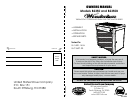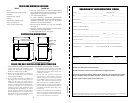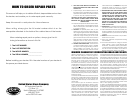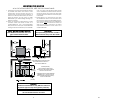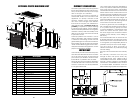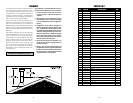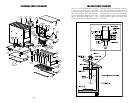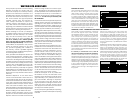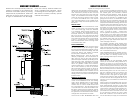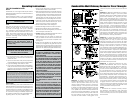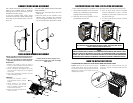
Masonry Chimneys have several positive
attributes: If properly built, they are quite
durable, and most homeowners consider
them more attractive perhaps than a non-
enclosed factory built chimney. And, if
the chimney is located within the connes
of the house (that is, not attached to an
exterior wall), its mass alone will store heat
longer and continue to release the heat
long after the re has died. Masonry chim-
neys have many disadvantages though.
Masonry chimneys constructed on an
exterior wall are exposed to cold outdoor
temperatures, promoting greater heater
loss, higher accumulations of creosote,
and reduced draft which leads to poorer
heater or furnace performance.
When considering a masonry chimney,
round tiles are preferable to square or
rectangular, as round tiles have much
better airow characteristics and are far
easier to clean. Unfortunately, most North
American chimneys use square or rectan-
gular tile liners that are really designed for
open replaces, not stoves or furnaces. Of
most importance, second only to overall
chimney height, is the diameter of the ue
liner itself. In most instances, it should be
sized to the appliance; i.e., 6” ue outlet
on the appliance requires a 6” ue. The
inner diameter should never be less than
the ue outlet diameter and should never
be greater than 50% of the appliance
ue outlet. For example, do not expect a
wood burning stove or furnace to function
properly if installed into a chimney with a
ue liner greater than 50% the appliance
outlet -- such as a 6” ue outlet requires
a 6” diameter for optimum drafting, but
can function well with an 8”, but becomes
borderline beyond 8” diameter.
Masonry chimneys built of concrete blocks
without ue liners of at least 5/8” reclay
do not meet modern building codes. A
solid fuel appliance must not be joined
to a chimney ue which is connected to
another appliance burning other fuels.
If your chimney has a typically oversized
ue liner of 8x12 inches or greater, or if it is
unlined, it will be necessary for you to reline
the chimney, using many of the modern
approved and economical methods such
as stainless steel, castable refractory, or
properly sized reclay linings.
If you have any question regarding vent-
ing your appliance, feel free to contact
the factory at the address and phone
number on this Owner’s Manual. You may
also contact NFPA (National Fire Protection
Association) and request NFPA Standard
211 (1984 Edition). Their address is Battery
March Park, Quincy, Massachusetts 02269.
Another helpful publication is NFPA Stan-
dard 908, available at the same address.
Specify 1984 Edition on either of the above
publications.
continued...
In the unlikely event that your heater “overres”
(a condition evidenced by elbows, stove pipes,
and connectors glowing red in appearance or
otherwise discoloring), then your installation
is subject to excessive draft created by either
a chimney too tall or too great in diameter in
conjunction with its height, or some other factor
of an indeterminate cause. In this event, you
should install a barometric draft regulator. Such
installation will preclude any over-ring and/
or any hazardous consequences of potential
overring.
Barometric draft regulators are generally avail-
able where you purchased your stove or may
be ordered directly from United States Stove
Company at a nominal charge.
to a near closed position - but leave the ash
pit damper at least partially open to prevent
the re from going out. Adjust the stove pipe
damper to reduce the draft on the re. With an-
thracite there will be short blue ames above
the coal, except when the re is started or a
new charge is added. If, however, there is no
ame then the re needs more air from the bot-
tom (unless it is near the end of its burn cycle
and needs to be recharged).
Only when the coal is burned down to half its
original depth it is time to add fresh coal. When
doing so, open the stove pipe damper and turn
the thermostat damper to high, which will al-
low the re to burn off any accumulated gases.
Open the feed door, and with a small rake,
hoe, or hooked poker pull the glowing coals
to the front of the rebox. Try not to disturb
the re too much. Next, add a fresh charge
to the back being careful not to seal off the
top. Close the feed door, but leave the spin
damper (or thermostat) open for a few minutes
until the volatile gases have burned off. It is not
necessary to shake down the ashes each time
you refuel the furnace. Experience will be your
best teacher.
BANKING THE FIRE:
For extended operation, such as overnight, the
re will need to be banked. To do so heap coal
up along the sides and back of the rebox so
that the re gradually burns it over a longer
period of time. The intensity of the re will also
be reduced without letting it go out. Follow the
same procedure as for refueling. If possible,
avoid shaking, as a heavier layer of ash will
help reduce the intensity of the re during this
time. After loading, let the re establish itself for
about 30 minutes. Then close your damper and
automatic control to the point where the house
does not become too cold. It is important that
you begin banking early enough before retiring
or leaving that you can make necessary adjust-
ments after the re is well established.
To revive a coal re that is almost out, (1) open
the ash door and stove pipe damper and close
the spin damper under the door to get a good
draft through the grate. (2) place a thin layer of
dry coal over the entire top of the re. DO NOT
POKE OR SHAKE THE FIRE AT THIS TIME! (3) after
the fresh coal has become well ignited shake
the grate (just a little), refuel.
916
Wish your blower would turn ON and OFF as
the heater gets warm and cold? It can with
this optional kit from U.S. Stove. It connects in
line with your power supply cord and mounts
to the back of the heater. When the snap disc
reaches 120 degrees, the blower automatically
turns ON and turns itself OFF if it reaches 90 de-
grees. See your Dealer for details or call U.S.
Stove directly.



